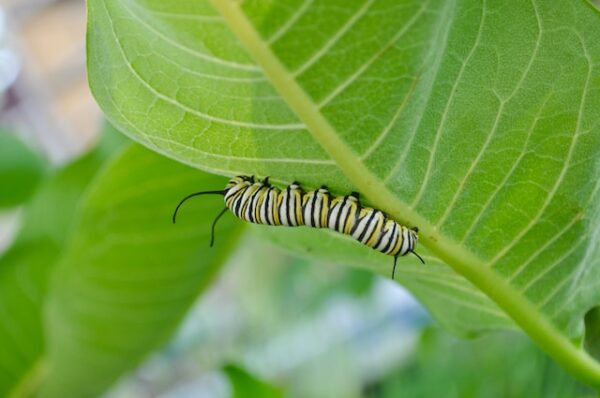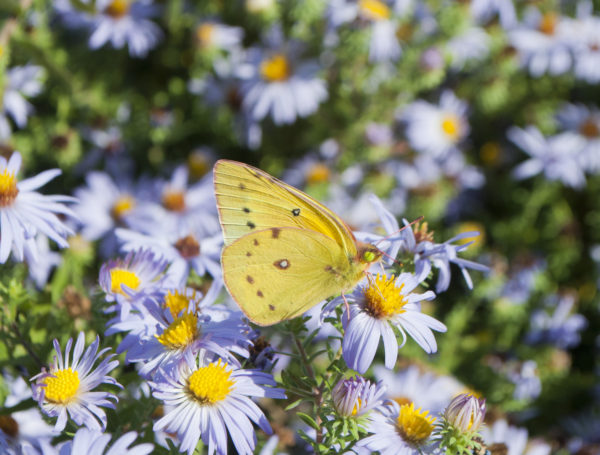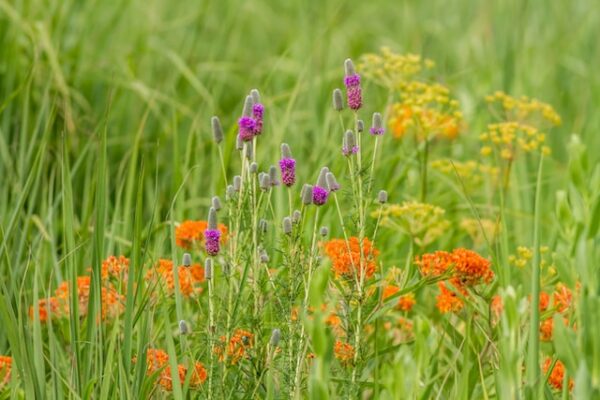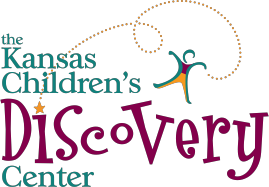About the Garden
Powell Memorial Butterfly Garden and Monarch Waystation is located at the Kansas Children's Discovery Center, at the entrance of the tallgrass prairie. The garden provides food and drink for pollinators, nesting sites for native bees and birds, and host plants for butterflies.

Why Care About Pollinators?
About one in three bites of our food and drink require a pollinator. Fruit, nuts, vegetables, grains—coffee and chocolate too. They provide a vital ecological service that is essential to the health of the environment. Pollinators are a keystone species & central to the lives of other wildlife. For example, the bumblebee feeds on the huckleberry flowers, pollinating them to produce fruit, which is eaten by songbirds, grizzly bears and other animals-- including us. The economic value of insect pollination worldwide has been estimated at $217 billion. Plus, pollinators are beautiful and fascinating.

What is Pollination?
Pollination is the process by which plants reproduce by making fertile seeds. Almost 75% of all plants on earth require an animal for pollination. Pollinators evolved together with native plants, which are best adapted to our local climate, soil and growing season. Like all organisms that rely on sexual reproduction, plants have male and female structures, which vary from flower to flower in a variety of configurations. Pollen grains contain the plant’s male cells, which travel down the female structures to reach the ovary and achieve fertilization. When pollen is not transferred no seed is formed. Inadequate pollination produces a fruit with few seeds and a small, lopsided fruit.

How Pollen Travels
Some plants can pollinate themselves; but half of all flowering plants need pollen from another plant. And since they are rooted to the ground, they need help from wind or an animal. Wind carries pollen but the chance of it reaching its target flower is low. So the blossoms must produce millions of pollen grains to succeed. People with hay fever understand this all too well! Flowers actively attract pollinators with bright petals, sweet scents and rewards like sugar-rich nectar to fuel flight and protein-rich pollen to feed their young. Flowers stop producing nectar after they are fertilized and some change color to signal an insect to look elsewhere.

Who Are the Pollinators?
Bats and birds can pollinate, but the vast majority of pollinating creatures are insects. Pollinating insects fall into four major groups:
- Bees and wasps
- Flies
- Butterflies and moths
- Beetles
Bee species out pollinate all other groups and are by far the most effective because they feed only on flowers. Although important to agriculture, honeybees are not native to North America, and Native Bees are far more efficient pollinators than honeybees. In a study of cherry orchards, Blue Orchard bees produced more than twice the fruit that honeybees did. Native bees work longer hours per day and also forage in wet and cold conditions, while honeybees stay in the hive. In early spring, native bees need flowers like golden current, serviceberry and chokecherry.
Of the 4,000 bee species in North America, more than three fourths are solitary, not social. Each female makes her own nest and feeds her young without help. She has extraordinary engineering skills in building this nest. Before she closes each brood cell, she leaves food, a loaf of nectar and pollen—“bee bread”—for her offspring. She then lays an egg and seals the cell. As she lays this tiny white sausage-like egg, she can control whether it will hatch into a female or male.

Plant Your Garden to attract Pollinators
- Plant native plants, which are adapted to our local soil and climate.
- Plant flowers:
- In big clumps so butterflies can find them
- In a variety of colors and shapes—like tubular penstemon for long tongues and sunflowers for short tongues.
- In assorted varieties that bloom continuously from early spring to late fall.
- Avoid double flowers with no scent, pollen or nectar.
- Plant a variety of host plants for caterpillars. Many butterflies and moths are specialists. Tiger Swallowtails need PawPaw trees. Giant Swallowtails need Prickly Ash.
- Go chemical-free. Pesticides and herbicides kill pollinators. Find plants and seeds that are untreated. Native and organic plants are safe.
- Protect nest sites of native bees, 70% of which lay eggs underground. They need sunny, bare, well-drained soil to excavate their nests. Leave some messy habitat for bees to lay their eggs. Old stumps, rotten logs and pithy plant stems are all bee condos!
- Help people learn about pollinators by planting gardens, schools, farms or parks with food plants they need to survive.
